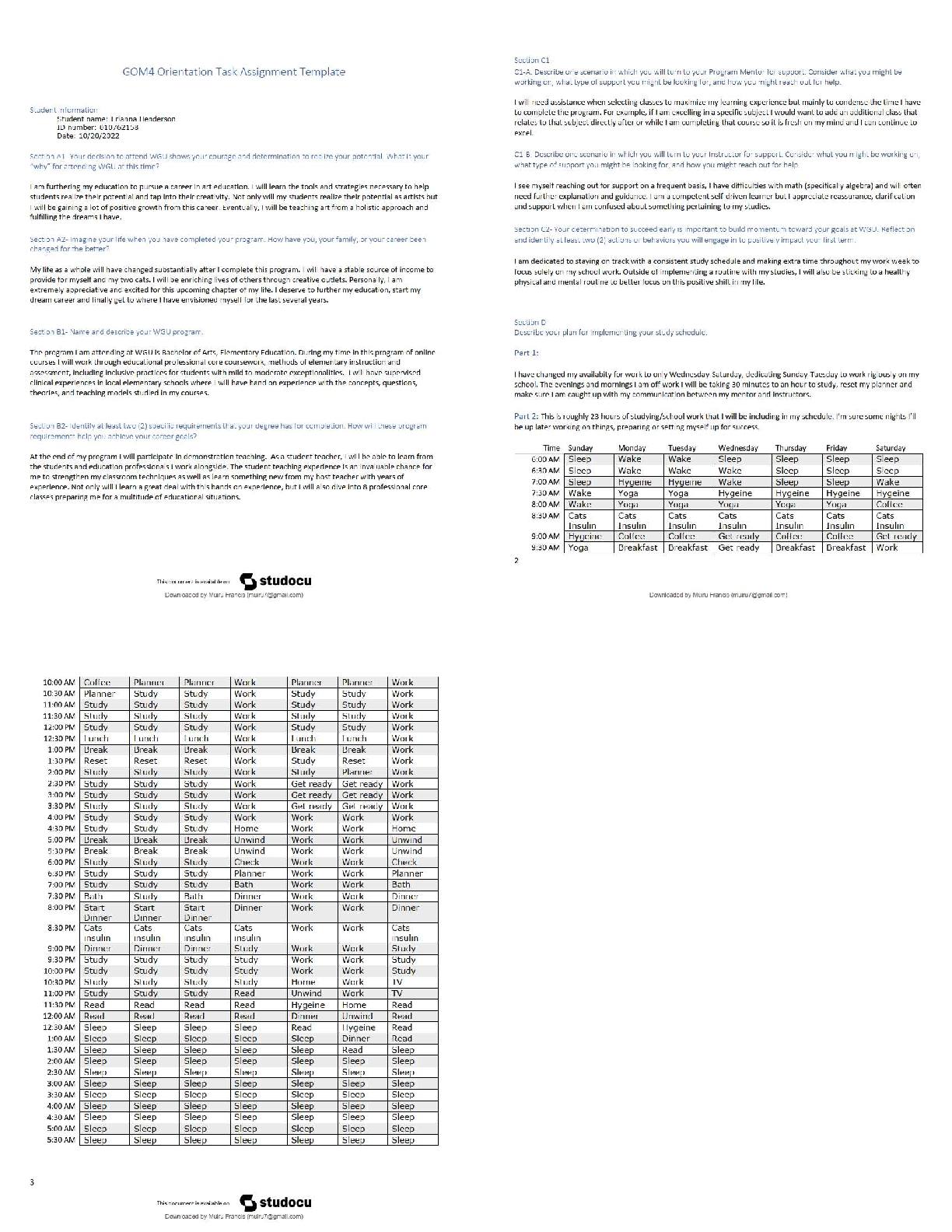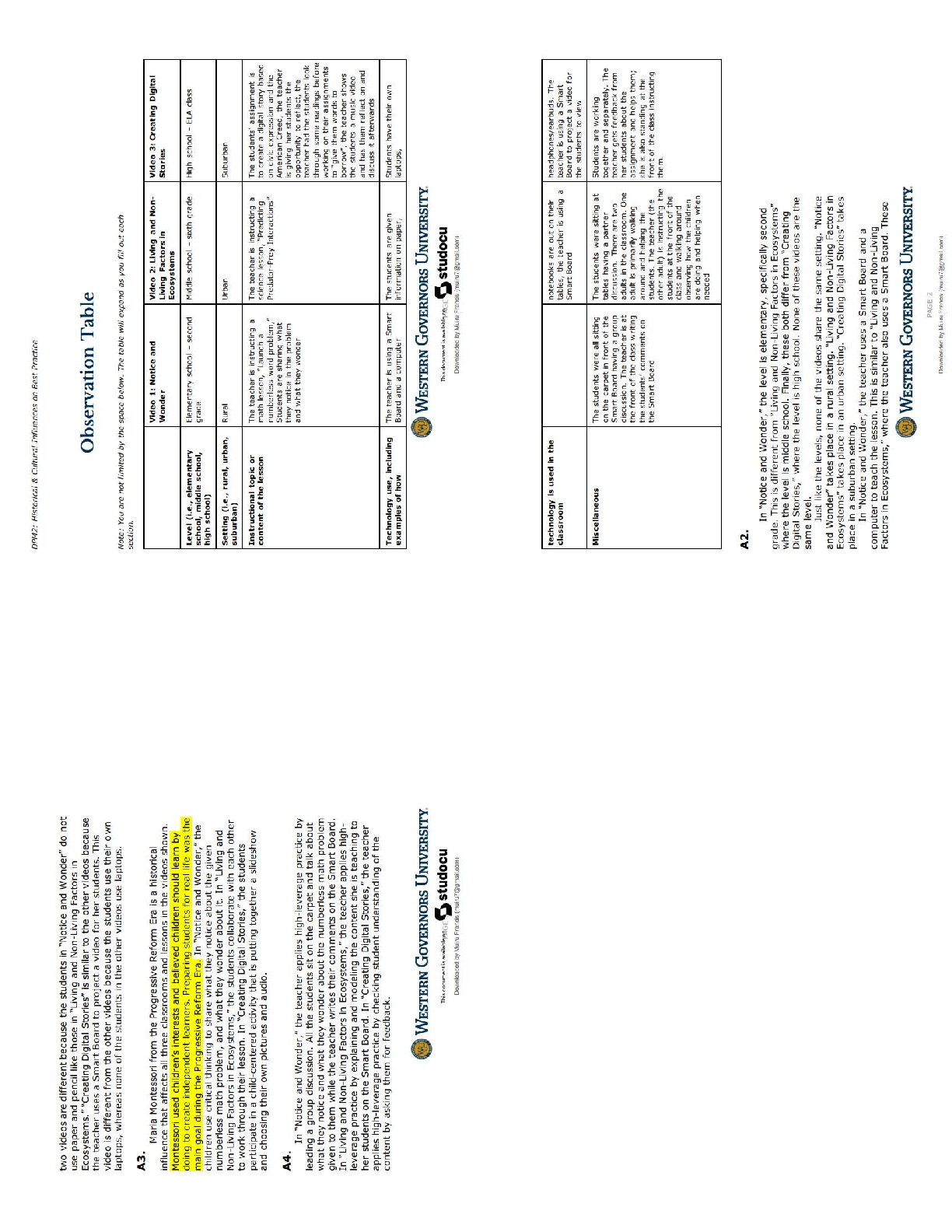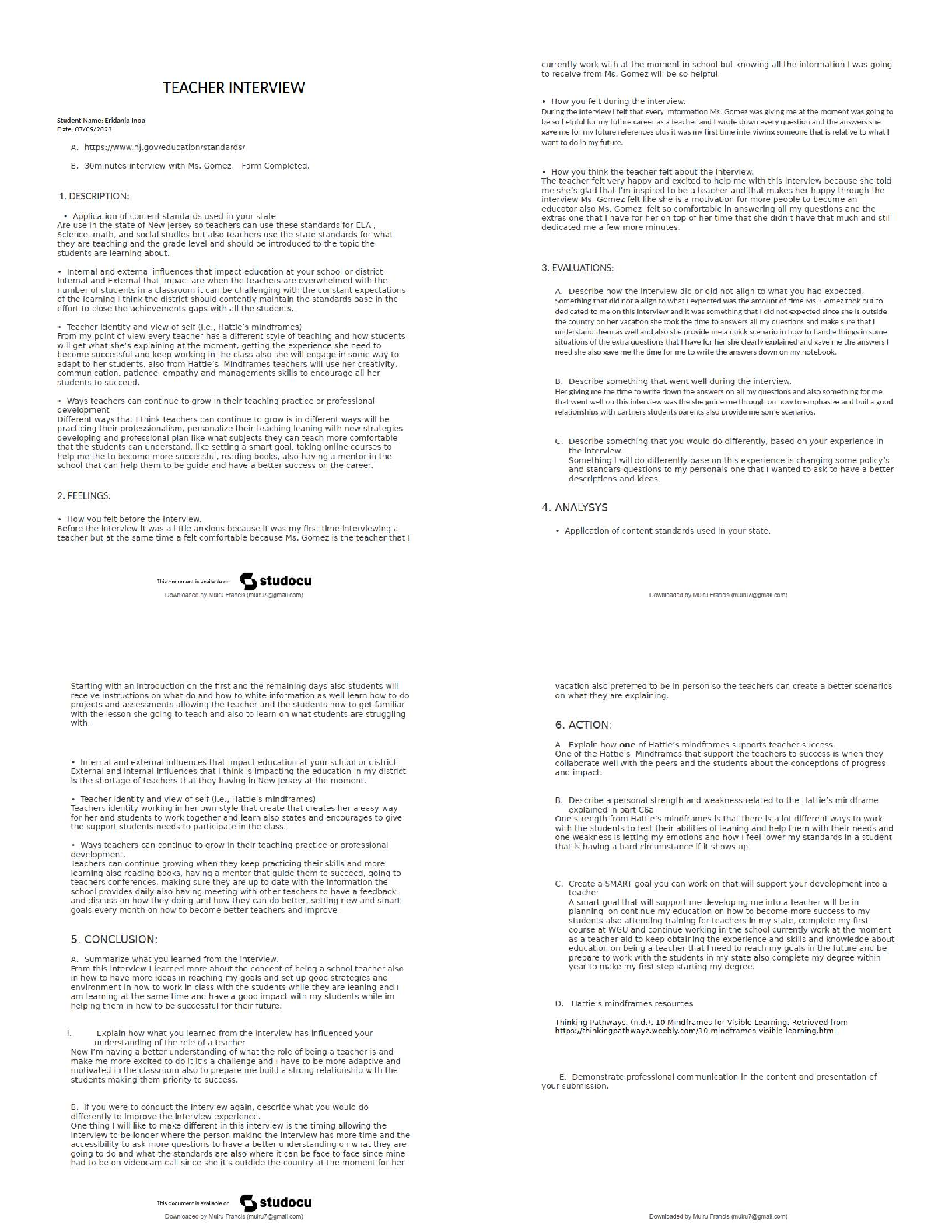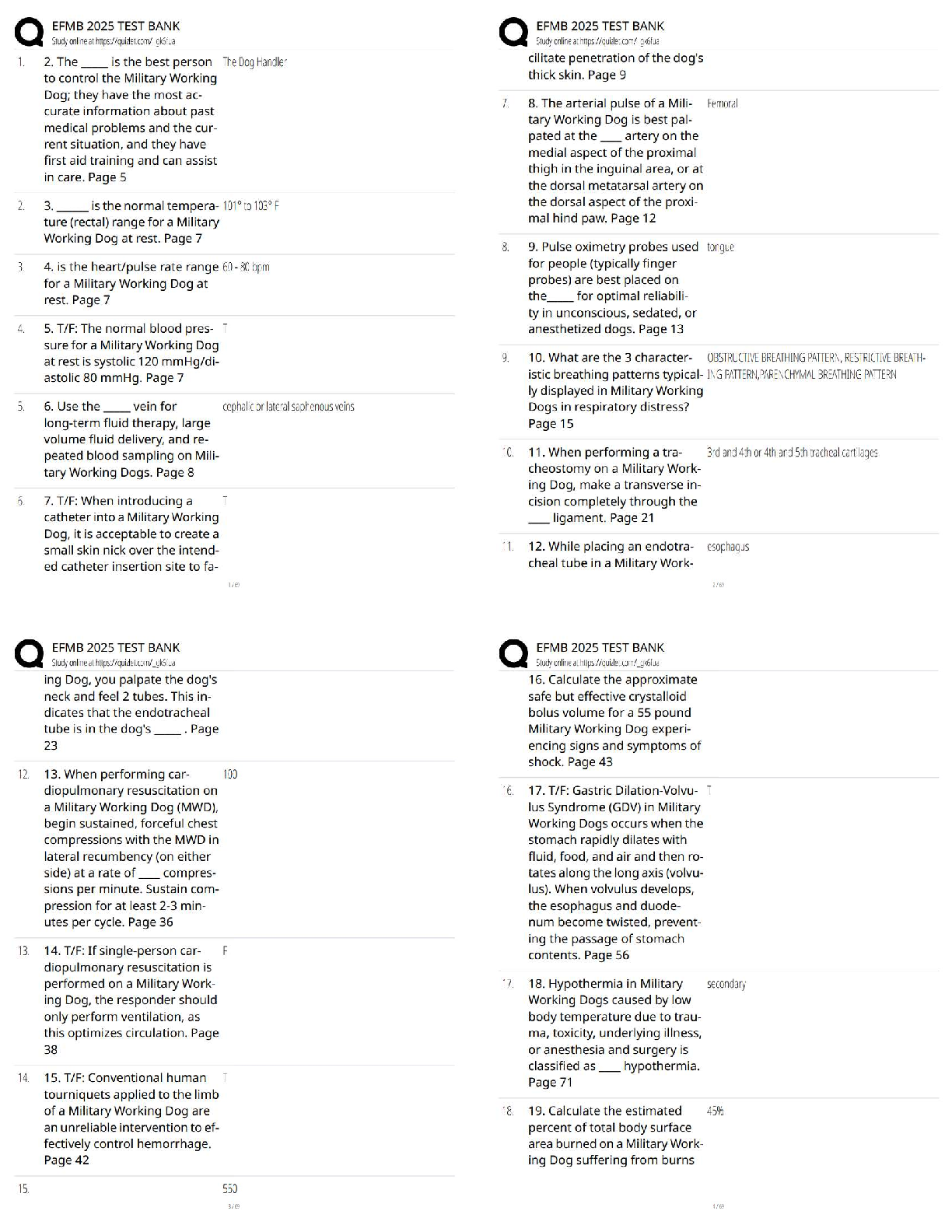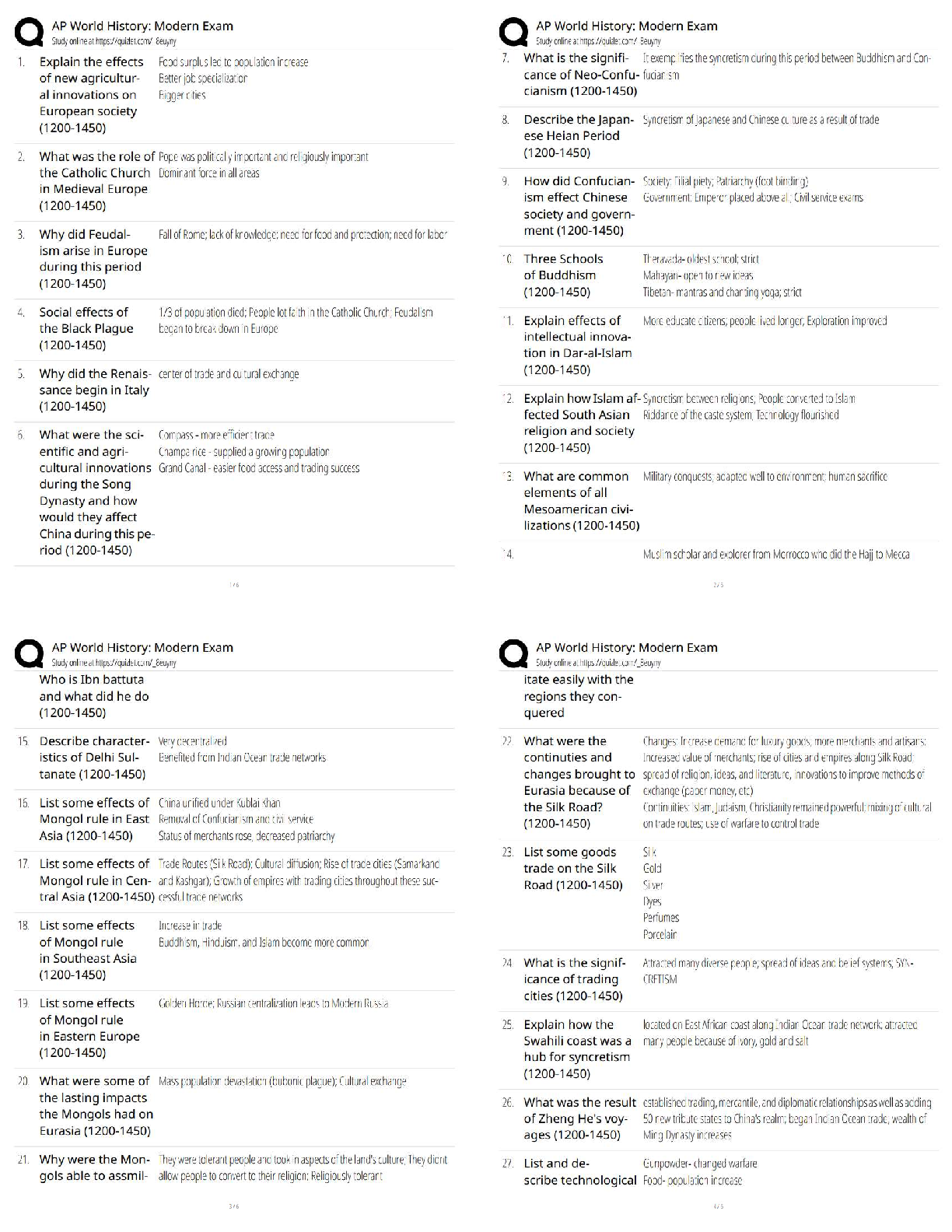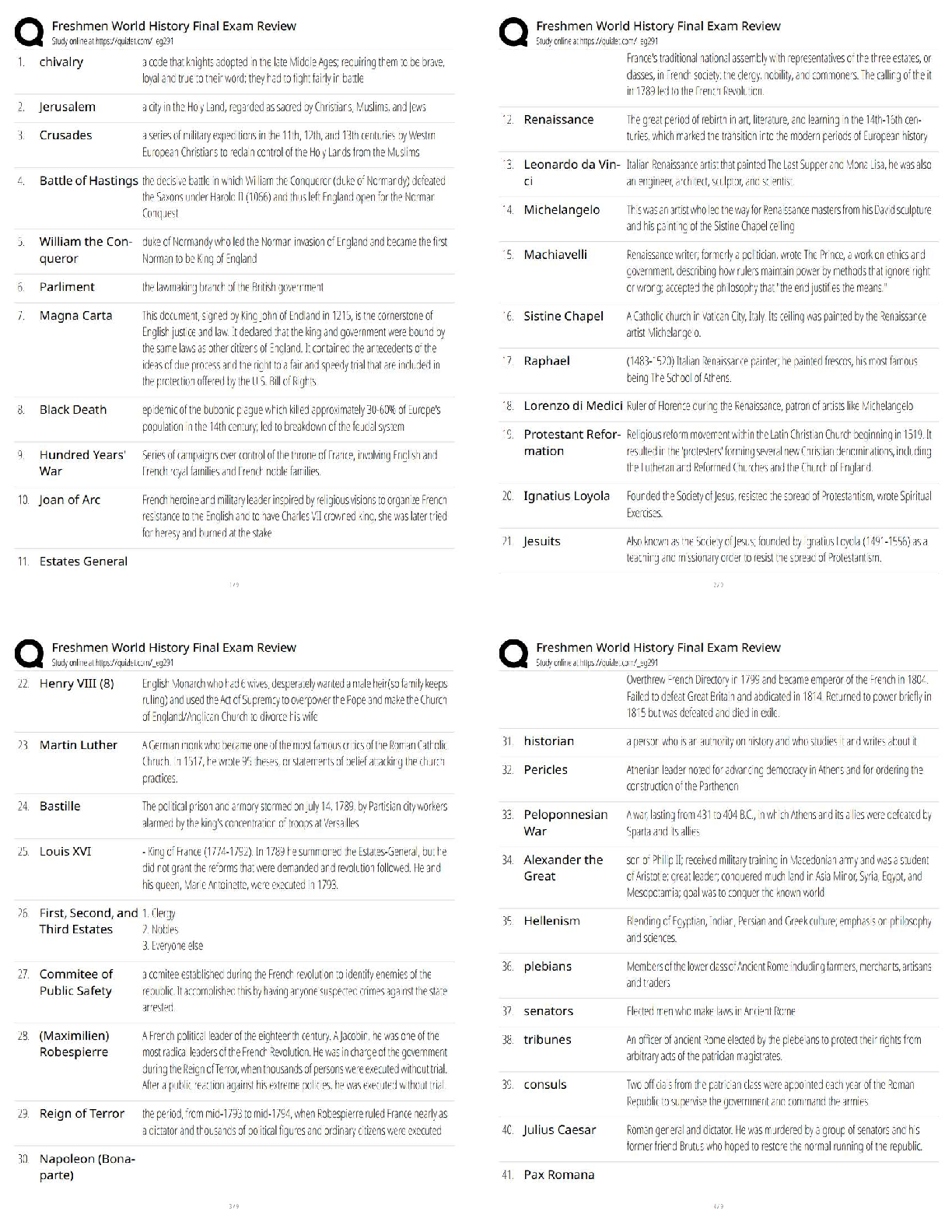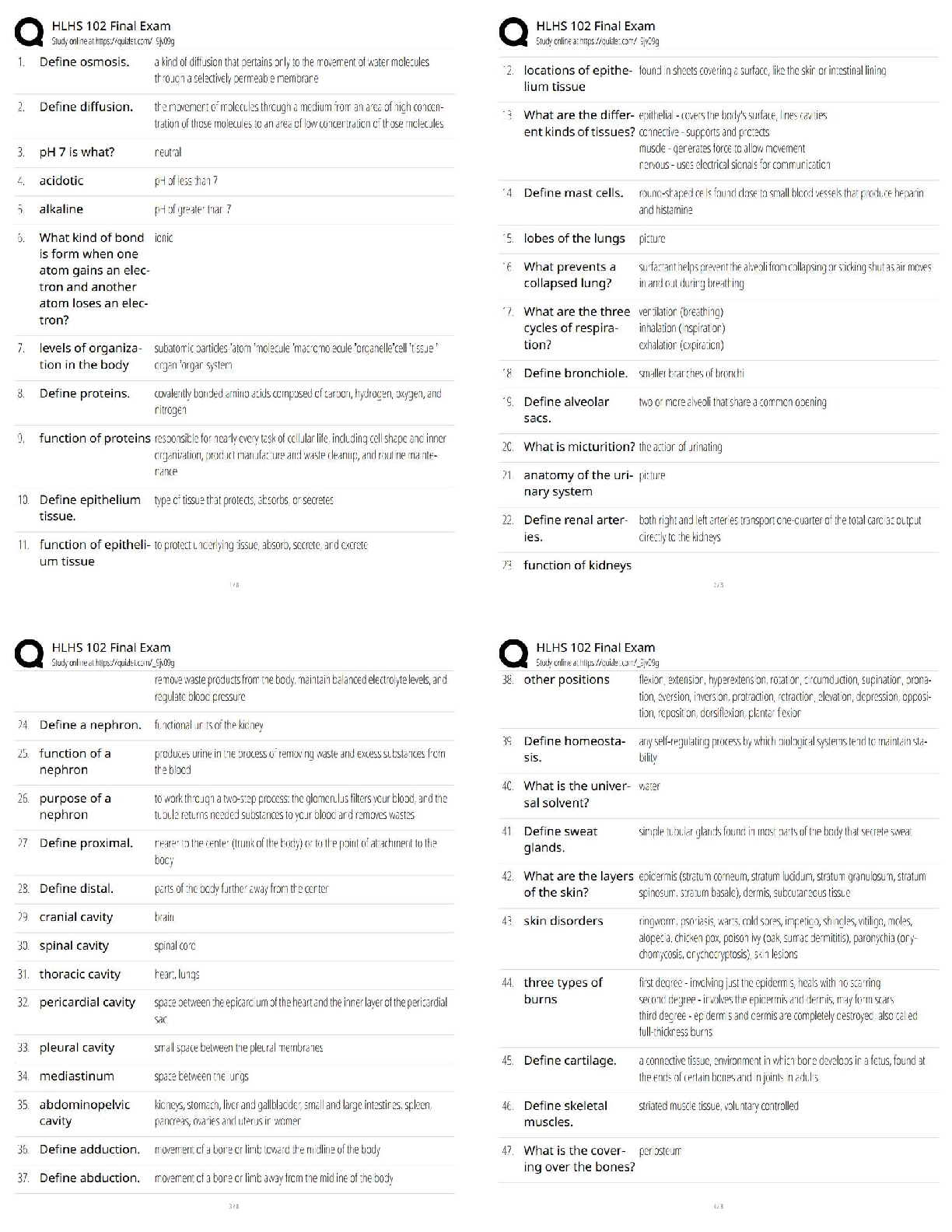Chapter 13—Measurement. All Answers
Document Content and Description Below
TRUE/FALSE
1. Measurement is the process of describing some property of a phenomenon, usually by assigning numbers, in a reliable and valid way.
T PTS: 1 DIF: Easy REF: p. 289
OBJ: LO: 13-01
...
NAT: AACSB Reflective Thinking| CB&E Model Research| Blooms Knowledge
2. In measurement, whenever a number is used to assign a value to an observation, the researcher must assign this number according to some predetermined rule.
T PTS: 1 DIF: Moderate REF: p. 289
OBJ: LO: 13-01
NAT: AACSB Reflective Thinking| CB&E Model Research| Blooms Comprehension
3. All measurement, particularly in the social sciences, contains error.
T PTS: 1 DIF: Moderate REF: p. 292
OBJ: LO: 13-01
NAT: AACSB Reflective Thinking| CB&E Model Research| Blooms Comprehension
4. Correspondence analysis is the process of identifying scale devices that correspond to properties of a concept involved in a research process.
F
This is called operationalization.
PTS: 1 DIF: Moderate REF: p. 292 OBJ: LO: 13-01
NAT: AACSB Reflective Thinking| CB&E Model Research| Blooms Knowledge
5. Scales measure concepts.
T PTS: 1 DIF: Moderate REF: p. 292
OBJ: LO: 13-01
NAT: AACSB Reflective Thinking| CB&E Model Research| Blooms Comprehension
6. A construct is a term used for concepts that are measured with single variables.
F
Constructs are measured with multiple variables.
PTS: 1 DIF: Moderate REF: p. 293 OBJ: LO: 13-01
NAT: AACSB Reflective Thinking| CB&E Model Research| Blooms Knowledge
7. How we define a construct will affect the way we measure it.
T PTS: 1 DIF: Hard REF: p. 293
OBJ: LO: 13-01
NAT: AACSB Reflective Thinking| CB&E Model Research| Blooms Comprehension
8. A ratio scale is the simplest type of measurement scale.
F
A nominal scale is the most elementary level of measurement.
PTS: 1 DIF: Moderate REF: p. 293 OBJ: LO: 13-02
NAT: AACSB Reflective Thinking| CB&E Model Research| Blooms Knowledge
9. A measurement scale in which respondents are asked to rank items based on their preferences is called a nominal scale.
F
This is an ordinal scale.
PTS: 1 DIF: Moderate REF: p. 295 OBJ: LO: 13-02
NAT: AACSB Reflective Thinking| CB&E Model Research| Blooms Knowledge
10. The most sophisticated form of data analysis for a nominal scale is the average of the scores.
F
Nominal scale properties mean the numbering system simply identifies things, so mathematical functions like averaging should not be performed.
PTS: 1 DIF: Hard REF: p. 296 OBJ: LO: 13-02
NAT: AACSB Reflective Thinking| CB&E Model Research| Blooms Comprehension
11. The Fahrenheit temperature scale is an example of a ratio scale.
F
It is an example of an interval scale.
PTS: 1 DIF: Moderate REF: p. 397 OBJ: LO: 13-02
NAT: AACSB Reflective Thinking| CB&E Model Research| Blooms Application
12. Interval scales represent the absolute meaning of the numbers on the scale.
F
Ratio scales do this. Interval scales do capture information about differences in quantities of a concept, though.
PTS: 1 DIF: Moderate REF: p. 397 OBJ: LO: 13-02
NAT: AACSB Reflective Thinking| CB&E Model Research| Blooms Comprehension
13. In ratio scales, the location of the zero point is arbitrary.
F
Ratio scales have an absolute zero. This is what distinguishes a ratio scale from an interval scale because zero in a ratio scale has meaning in that it represents an absence of some concept.
PTS: 1 DIF: Moderate REF: p. 297 OBJ: LO: 13-02
NAT: AACSB Reflective Thinking| CB&E Model Research| Blooms Comprehension
14. Money is an example of something that can be measured using a ratio scale.
T PTS: 1 DIF: Moderate REF: p. 297
OBJ: LO: 13-02
NAT: AACSB Reflective Thinking| CB&E Model Research| Blooms Comprehension
15. Mathematical operations cannot be performed with numbers from nominal scales.
F
While it is true that mathematical operations can be performed with numbers from nominal scales, the result may not have a great deal of meaning.
PTS: 1 DIF: Moderate REF: p. 298 OBJ: LO: 13-02
NAT: AACSB Reflective Thinking| CB&E Model Research| Blooms Comprehension
16. Discrete measures are those that take on only one of a finite number of values.
T PTS: 1 DIF: Moderate REF: p. 298
OBJ: LO: 13-02
NAT: AACSB Reflective Thinking| CB&E Model Research| Blooms Knowledge
17. Continuous measures are those assigning values anywhere along some scale range in a place that corresponds to the intensity of some concept.
T PTS: 1 DIF: Moderate REF: p. 299
OBJ: LO: 13-02
NAT: AACSB Reflective Thinking| CB&E Model Research| Blooms Knowledge
18. Interval scales are considered continuous when five or more categories are used.
T PTS: 1 DIF: Hard REF: p. 299
OBJ: LO: 13-02
NAT: AACSB Reflective Thinking| CB&E Model Research| Blooms Comprehension
19. An attribute is a single characteristic or fundamental feature of an object, person, situation, or issue.
T PTS: 1 DIF: Moderate REF: p. 299
OBJ: LO: 13-03
NAT: AACSB Reflective Thinking| CB&E Model Research| Blooms Knowledge
20. An index measure assigns a value based on how characteristic an observation is of the thing being measured.
T PTS: 1 DIF: Moderate REF: p. 299
OBJ: LO: 13-03
NAT: AACSB Reflective Thinking| CB&E Model Research| Blooms Knowledge
21. A scale can be created by simply adding together the responses to several items related to a topic.
T PTS: 1 DIF: Moderate REF: p. 300
OBJ: LO: 13-03
NAT: AACSB Reflective Thinking| CB&E Model Research| Blooms Comprehension
22. Sometimes respondents’ answers need to be assigned opposite values through a process called cross-validation.
F
This process is called reverse coding.
PTS: 1 DIF: Moderate REF: p. 300 OBJ: LO: 13-03
NAT: AACSB Reflective Thinking| CB&E Model Research| Blooms Comprehension
23. The three major criteria for evaluating measurements are reliability, validity, and replicability.
F
The three major criteria for evaluating measurements are reliability, validity, and sensitivity.
PTS: 1 DIF: Moderate REF: p. 301 OBJ: LO: 13-04
NAT: AACSB Reflective Thinking| CB&E Model Research| Blooms Knowledge
24. Reliability is an indicator of a measure’s internal consistency.
T PTS: 1 DIF: Moderate REF: p. 301
OBJ: LO: 13-04
NAT: AACSB Reflective Thinking| CB&E Model Research| Blooms Knowledge
25. A measuring instrument is valid when the results can be repeated at subsequent measurements of the concept.
F
This is reliability. Validity refers to the extent to which a score truthfully represents a concept.
PTS: 1 DIF: Moderate REF: p. 301 OBJ: LO: 13-04
NAT: AACSB Reflective Thinking| CB&E Model Research| Blooms Knowledge
26. Internal consistency represents a measure’s heterogeneity.
F
Internal consistency represents a measure’s homogeneity.
PTS: 1 DIF: Moderate REF: p. 302 OBJ: LO: 13-04
NAT: AACSB Reflective Thinking| CB&E Model Research| Blooms Knowledge
27. Coefficient alpha is the most commonly applied estimate of a composite scale’s reliability.
T PTS: 1 DIF: Moderate REF: p. 302
OBJ: LO: 13-05
NAT: AACSB Reflective Thinking| CB&E Model Research| Blooms Knowledge
28. Validity is the extent to which a score truthfully represents a concept.
T PTS: 1 DIF: Moderate REF: p. 303
OBJ: LO: 13-04
NAT: AACSB Reflective Thinking| CB&E Model Research| Blooms Knowledge
29. Content validity is the ability of a measure to correlate with other standard measures of similar constructs or established criteria.
F
This is criterion validity.
PTS: 1 DIF: Moderate REF: p. 304 OBJ: LO: 13-05
NAT: AACSB Reflective Thinking| CB&E Model Research| Blooms Knowledge
30. Discriminant validity is another way of expressing internal consistency.
F
This is convergent validity. Discriminant validity represents how unique or distinct is a measure.
PTS: 1 DIF: Moderate REF: p. 305 OBJ: LO: 13-05
NAT: AACSB Reflective Thinking| CB&E Model Research| Blooms Knowledge
MULTIPLE CHOICE
1. _____ is the process of describing some property of a phenomenon, usually by assigning numbers, in a reliable and valid way.
a. Research
b. Analysis
c. Validation
d. Measurement
D PTS: 1 DIF: Easy REF: p. 289
OBJ: LO: 13-01
NAT: AACSB Reflective Thinking| CB&E Model Research| Blooms Knowledge
2. A researcher is observing fans at a soccer game and is putting a “1” if the fan is actively cheering and a “0” if they just seem to be merely watching the game without saying anything. He is also indicating which team the fan seems to be associated with as well as approximate age and gender. By recording information such as this with codes, the researcher is involved in _____.
a. conceptualization
b. operationalization
c. measurement
d. analysis
C PTS: 1 DIF: Hard REF: p. 289
OBJ: LO: 13-01
NAT: AACSB Reflective Thinking| CB&E Model Research| Blooms Application
3. Age, gender, brand loyalty, and corporate culture are all examples of _____.
a. concepts
b. scales
c. ratios
d. codes
A PTS: 1 DIF: Hard REF: p. 292
OBJ: LO: 13-01
NAT: AACSB Reflective Thinking| CB&E Model Research| Blooms Application
4. A(n) _____ is a generalized idea that represents something of identifiable and distinct meaning.
a. scale
b. concept
c. operant
d. measure
B PTS: 1 DIF: Moderate REF: p. 292
OBJ: LO: 13-01
NAT: AACSB Reflective Thinking| CB&E Model Research| Blooms Knowledge
5. _____ is the process of identifying scale devices that correspond to properties of a concept involved in a research process.
a. Conceptualization
b. Conversion
c. Correspondence
d. Operationalization
D PTS: 1 DIF: Moderate REF: p. 292
OBJ: LO: 13-01
NAT: AACSB Reflective Thinking| CB&E Model Research| Blooms Comprehension
6. Researchers measure concepts through a process known as _____.
a. summation
b. operationalization
c. assessment
d. matching
B PTS: 1 DIF: Moderate REF: p. 292
OBJ: LO: 13-01
NAT: AACSB Reflective Thinking| CB&E Model Research| Blooms Knowledge
7. Which of the following is a device providing a range of values that correspond to different characteristics or amounts of a characteristic exhibited in observing a concept?
a. operations
b. reliability
c. sensitivity
d. scale
D PTS: 1 DIF: Moderate REF: p. 292
OBJ: LO: 13-01
NAT: AACSB Reflective Thinking| CB&E Model Research| Blooms Knowledge
8. Which of the following refers to concepts measured with multiple variables?
a. operation
b. construct
c. concept
d. scale
B PTS: 1 DIF: Moderate REF: p. 293
OBJ: LO: 13-01
NAT: AACSB Reflective Thinking| CB&E Model Research| Blooms Knowledge
9. In an observation study, when "shopping time in a supermarket" is defined as: "Using a stopwatch, start the stopwatch the moment the customer enters the store and stop the stopwatch as soon as the customer is handed a receipt by the checkout clerk," this is best described as an example of a(n) _____.
a. nominal scale
b. equivalent-form scale
c. operational definition
d. test-retest method
C PTS: 1 DIF: Hard REF: p. 293
OBJ: LO: 13-01
NAT: AACSB Reflective Thinking| CB&E Model Research| Blooms Application
10. Scales that assign a value to an object for identification or classification purposes are called _____ scales.
a. ordinal
b. nominal
c. interval
d. ratio
B PTS: 1 DIF: Moderate REF: p. 293
OBJ: LO: 13-02
NAT: AACSB Reflective Thinking| CB&E Model Research| Blooms Knowledge
11. Which of the following is the most elementary level of measurement?
a. nominal scale
b. ordinal scale
c. ratio scale
d. interval scale
A PTS: 1 DIF: Moderate REF: p. 293
OBJ: LO: 13-02
NAT: AACSB Reflective Thinking| CB&E Model Research| Blooms Comprehension
12. Coding household income into "Above $100,000," "Between $50,000 and $100,000," and "Below $50,000" is an example of a(n) ______ scale.
a. interval
b. test-retest
c. criterion
d. nominal
D PTS: 1 DIF: Hard REF: p. 293
OBJ: LO: 13-02
NAT: AACSB Reflective Thinking| CB&E Model Research| Blooms Application
13. A scale that allows things to be arranged based on how much of some concept they possess is called a(n) _____ scale.
a. quantitative scale
b. nominal
c. ordinal
d. order
C PTS: 1 DIF: Moderate REF: p. 295
OBJ: LO: 13-02
NAT: AACSB Reflective Thinking| CB&E Model Research| Blooms Knowledge
14. Which type of scale is, at the most, a ranking scale?
a. ratio
b. interval
c. nominal
d. ordinal
D PTS: 1 DIF: Moderate REF: p. 295
OBJ: LO: 13-02
NAT: AACSB Reflective Thinking| CB&E Model Research| Blooms Comprehension
15. When job candidates are asked to place job listings so that their first choice is 1, their second choice is 2, and so forth, this is best-described as an example of a(n) ______ scale.
a. ordinal
b. ratio
c. interval
d. nominal
A PTS: 1 DIF: Hard REF: p. 295
OBJ: LO: 13-02
NAT: AACSB Reflective Thinking| CB&E Model Research| Blooms Application
16. A scale which arranges brands in an ordered sequence in which there is an equal interval between each point on the scale is an example of a(n) ______ scale.
a. interval
b. ratio
c. nominal
d. ordinal
A PTS: 1 DIF: Moderate REF: p. 297
OBJ: LO: 13-02
NAT: AACSB Reflective Thinking| CB&E Model Research| Blooms Knowledge
17. The Fahrenheit temperature scale is best described as an example of a(n) ______ scale because it doesn’t have an absolute zero point.
a. ratio
b. nominal
c. interval
d. ordinal
C PTS: 1 DIF: Hard REF: p. 397
OBJ: LO: 13-02
NAT: AACSB Reflective Thinking| CB&E Model Research| Blooms Application
18. Which type of scale has all the properties of an interval scale with the additional attribute of representing absolute quantities, characterized by a meaningful absolute zero?
a. nominal scale
b. discrete scale
c. infinite scale
d. ratio scale
D PTS: 1 DIF: Moderate REF: p. 297
OBJ: LO: 13-02
NAT: AACSB Reflective Thinking| CB&E Model Research| Blooms Knowledge
19. Which type of scale represents the highest form of measurement?
a. nominal scale
b. ordinal
c. ratio
d. interval
C PTS: 1 DIF: Moderate REF: p. 297
OBJ: LO: 13-02
NAT: AACSB Reflective Thinking| CB&E Model Research| Blooms Comprehension
20. A company’s stock price is best described as an example of a(n) ______ scale.
a. ordinal
b. interval
c. ratio
d. nominal
C PTS: 1 DIF: Hard REF: p. 297
OBJ: LO: 13-02
NAT: AACSB Reflective Thinking| CB&E Model Research| Blooms Application
21. Which of the following is a defining characteristic in determining between ratio and interval scales?
a. number of items
b. absolute zero
c. number of intervals
d. nominal values
B PTS: 1 DIF: Moderate REF: p. 297
OBJ: LO: 13-02
NAT: AACSB Reflective Thinking| CB&E Model Research| Blooms Comprehension
22. All of the following can be measured using ratio scales EXCEPT _____.
a. gender
b. income
c. temperature
d. weight
A PTS: 1 DIF: Hard REF: p. 297
OBJ: LO: 13-02
NAT: AACSB Reflective Thinking| CB&E Model Research| Blooms Comprehension
23. Measures that can take on only one of a finite number of values are called _____.
a. discrete measures
b. neutral measures
c. limited measures
d. continuous measures
A PTS: 1 DIF: Moderate REF: p. 298
OBJ: LO: 13-02
NAT: AACSB Reflective Thinking| CB&E Model Research| Blooms Knowledge
24. Which of the following is a discrete measure?
a. nominal scales
b. sensitive scales
c. ratio scales
d. all of these choices
A PTS: 1 DIF: Hard REF: p. 298
OBJ: LO: 13-02
NAT: AACSB Reflective Thinking| CB&E Model Research| Blooms Comprehension
25. Measures that reflect the intensity of a concept by assigning values that can take on any value along some scale range are called _____.
a. discrete measures
b. continuous measures
c. absolute measures
d. valid measures
B PTS: 1 DIF: Moderate REF: p. 299
OBJ: LO: 13-02
NAT: AACSB Reflective Thinking| CB&E Model Research| Blooms Knowledge
26. Age is an example of a _____ measure.
a. nominal
b. biological
c. discrete
d. continuous
D PTS: 1 DIF: Hard REF: p. 299
OBJ: LO: 13-02
NAT: AACSB Reflective Thinking| CB&E Model Research| Blooms Application
27. A(n) _____ is a single characteristic or fundamental feature of an object, person, situation, or issue.
a. concept
b. variable
c. attribute
d. construct
C PTS: 1 DIF: Moderate REF: p. 299
OBJ: LO: 13-03
NAT: AACSB Reflective Thinking| CB&E Model Research| Blooms Knowledge
28. Gas mileage is an example of a(n) _____ of an automobile.
a. attribute
b. concept
c. measure
d. component
A PTS: 1 DIF: Hard REF: p. 299
OBJ: LO: 13-03
NAT: AACSB Reflective Thinking| CB&E Model Research| Blooms Application
29. Which type of measure assigns a value based on how much of the concept being measured is associated with an observation and is formed by putting several variables together systematically?
a. conglomerate measure
b. multiplicative measure
c. index measure
d. multidimensional measure
C PTS: 1 DIF: Moderate REF: p. 299
OBJ: LO: 13-03
NAT: AACSB Reflective Thinking| CB&E Model Research| Blooms Knowledge
30. Carla is using education, income, and occupation to develop a measure of social class. What type of measure for social class is she developing?
a. index measure
b. valid measure
c. reliable measure
d. concurrent measure
A PTS: 1 DIF: Hard REF: p. 299
OBJ: LO: 13-03
NAT: AACSB Reflective Thinking| CB&E Model Research| Blooms Application
31. Which type of measure assigns a value to an observation based on a mathematical derivation of multiple measures?
a. conglomerate measure
b. derivative measure
c. higher-order measure
d. composite measure
D PTS: 1 DIF: Moderate REF: p. 300
OBJ: LO: 13-03
NAT: AACSB Reflective Thinking| CB&E Model Research| Blooms Knowledge
32. A researcher is measuring consumers’ attitudes toward product placement in movies using five attitude items. She created a scale by simply summing the response to each item making up the composite measure. This composite measure is called a(n) _____.
a. derived scale
b. additive scale
c. summated scale
d. primary scale
C PTS: 1 DIF: Hard REF: p. 300
OBJ: LO: 13-03
NAT: AACSB Reflective Thinking| CB&E Model Research| Blooms Application
33. Which of the following means that the value assigned for a response is treated oppositely from the other items in a scale?
a. reverse coding
b. indexing
c. alpha coding
d. convergence
A PTS: 1 DIF: Moderate REF: p. 300
OBJ: LO: 13-03
NAT: AACSB Reflective Thinking| CB&E Model Research| Blooms Knowledge
34. Which of the following is an indicator of a measure’s internal consistency?
a. reliability
b. validity
c. coefficient beta
d. sensitivity
A PTS: 1 DIF: Moderate REF: p. 301
OBJ: LO: 13-04
NAT: AACSB Reflective Thinking| CB&E Model Research| Blooms Knowledge
35. _____ represents a measure’s homogeneity or the extent to which each indicator of a concept converges on a common meaning.
a. Internal consistency
b. Validity
c. Internal validity
d. External consistency
A PTS: 1 DIF: Moderate REF: p. 302
OBJ: LO: 13-04
NAT: AACSB Reflective Thinking| CB&E Model Research| Blooms Knowledge
36. When a researcher measures the reliability of an instrument by comparing the results of the odd-numbered questions with the results of the even-numbered questions, this is an example of _____ reliability.
a. test-retest
b. split-half
c. equivalent-forms
d. criterion
B PTS: 1 DIF: Moderate REF: p. 302
OBJ: LO: 13-05
NAT: AACSB Reflective Thinking| CB&E Model Research| Blooms Knowledge
37. The most commonly applied estimate of a composite scale’s reliability is _____.
a. coefficient alpha
b. coefficient beta
c. criterion coefficient
d. an index coefficient
A PTS: 1 DIF: Moderate REF: p. 302
OBJ: LO: 13-05
NAT: AACSB Reflective Thinking| CB&E Model Research| Blooms Comprehension
38. Which of the following represents the average of all possible split-half reliabilities for a construct?
a. R2
b.
c.
d.
C PTS: 1 DIF: Moderate REF: p. 302
OBJ: LO: 13-05
NAT: AACSB Reflective Thinking| CB&E Model Research| Blooms Knowledge
39. A researcher who administers the same scale to the same respondents at two separate times to test for stability is using which method of assessing the scale’s reliability?
a. coefficient alpha
b. split-half method
c. test-retest method
d. before/after method
C PTS: 1 DIF: Moderate REF: p. 302
OBJ: LO: 13-05
NAT: AACSB Reflective Thinking| CB&E Model Research| Blooms Knowledge
40. _____ is the accuracy of a measure or the extent to which a score truthfully represents a concept.
a. Reliability
b. Validity
c. Consistency
d. Authenticity
B PTS: 1 DIF: Moderate REF: p. 303
OBJ: LO: 13-04
NAT: AACSB Reflective Thinking| CB&E Model Research| Blooms Knowledge
41. The ability of a measuring instrument to measure what it is supposed to measure is the basic purpose of ______.
a. reliability
b. validity
c. sensitivity
d. indexing
B PTS: 1 DIF: Moderate REF: p. 303
OBJ: LO: 13-04
NAT: AACSB Reflective Thinking| CB&E Model Research| Blooms Knowledge
42. When a group of experts agrees that a measuring instrument measures what it is intended to measure, we say that the instrument has ______ validity.
a. face
b. criterion
c. test-retest
d. equivalent-forms
A PTS: 1 DIF: Moderate REF: p. 303
OBJ: LO: 13-04
NAT: AACSB Reflective Thinking| CB&E Model Research| Blooms Knowledge
43. All of the following are basic aspects of validity EXCEPT _____.
a. primary validity
b. face validity
c. construct validity
d. criterion validity
A PTS: 1 DIF: Hard REF: p. 304
OBJ: LO: 13-04
NAT: AACSB Reflective Thinking| CB&E Model Research| Blooms Comprehension
44. Which type of validity addresses the question, “Does my measure correlate with measures of similar concepts or known quantities?”
a. face validity
b. reliability validity
c. criterion validity
d. discriminant validity
45. When a two-point scale (e.g. agree/disagree) is expanded to include five categories (e.g. strongly disagree, disagree, undecided, agree, strongly agree), we say that the ________ of the scale has been increased.
a. sensitivity
b. reliability
c. predictive validity
d. criterion validity
COMPLETION
1. A generalized idea that represents something of meaning is called a(n) ______.
2. The process involving identifying scales that correspond to properties of a concept is called _____.
3. Scales provide _____ rules that indicate that a certain value on a scale corresponds to some true value of a concept.
4. A scale in which letters (e.g. A,B,C) are assigned to objects to serve as identification labels for the objects is called a(n) _____ scale.
5. A scale which arranges objects in order according to their relative magnitude to one another is called a(n) ______ scale.
6. A scale which arranges objects so that they are equally-distant from one another is called a(n) ______ scale.
7. A _____ scale has an absolute zero point.
8. Measures that take on only one of a finite number of values are called _____ measures.
9. Measures that assign values anywhere along some scale range in a place that corresponds to the intensity of some concept are called _____ measures.
10. A(n) _____ measure assigns a value to an observation based on a mathematical derivation of multiple variables.
11. _____ means that the value assigned for a response is treated oppositely from the other items.
12. The degree to which a measurement instrument yields consistent results is called the ______ of the instrument.
13. _____ is the most commonly applied estimate of a multiple item scale’s reliability and represents the average of all possible split-half reliabilities for a construct.
14. The _____ method of determining reliability involves administering the same scale or measure to the same respondents at two separate times to test for stability.
15. The ability of a measuring instrument to measure what it is supposed to measure is called its ______.
16. A scale that logically appears to reflect what was intended to be measured possesses _____ validity.
17. _____ validity is the degree that a measure covers the breadth of the domain of interest.
18. _____ validity consists of several components, including face validity, content validity, criterion validity, convergent validity, and discriminant validity.
19. _____ validity represents the uniqueness or distinctiveness of a measure.
20. The ability of a scale to measure the variability of a concept is called that scale’s ________ .
ESSAY
1. Explain the difference between a concept and a construct, giving an example of each.
2. Compare and contrast the four different levels of scale measurement.
3. Explain how indexes or composite measures are formed and give an example of how they are used in business research.
4. List the three criteria for good measurement.
5. Explain why researchers are concerned with scale reliability and discuss how it is assessed.
6. Name and describe the components of construct validity.
[Show More]
Last updated: 3 years ago
Preview 1 out of 18 pages

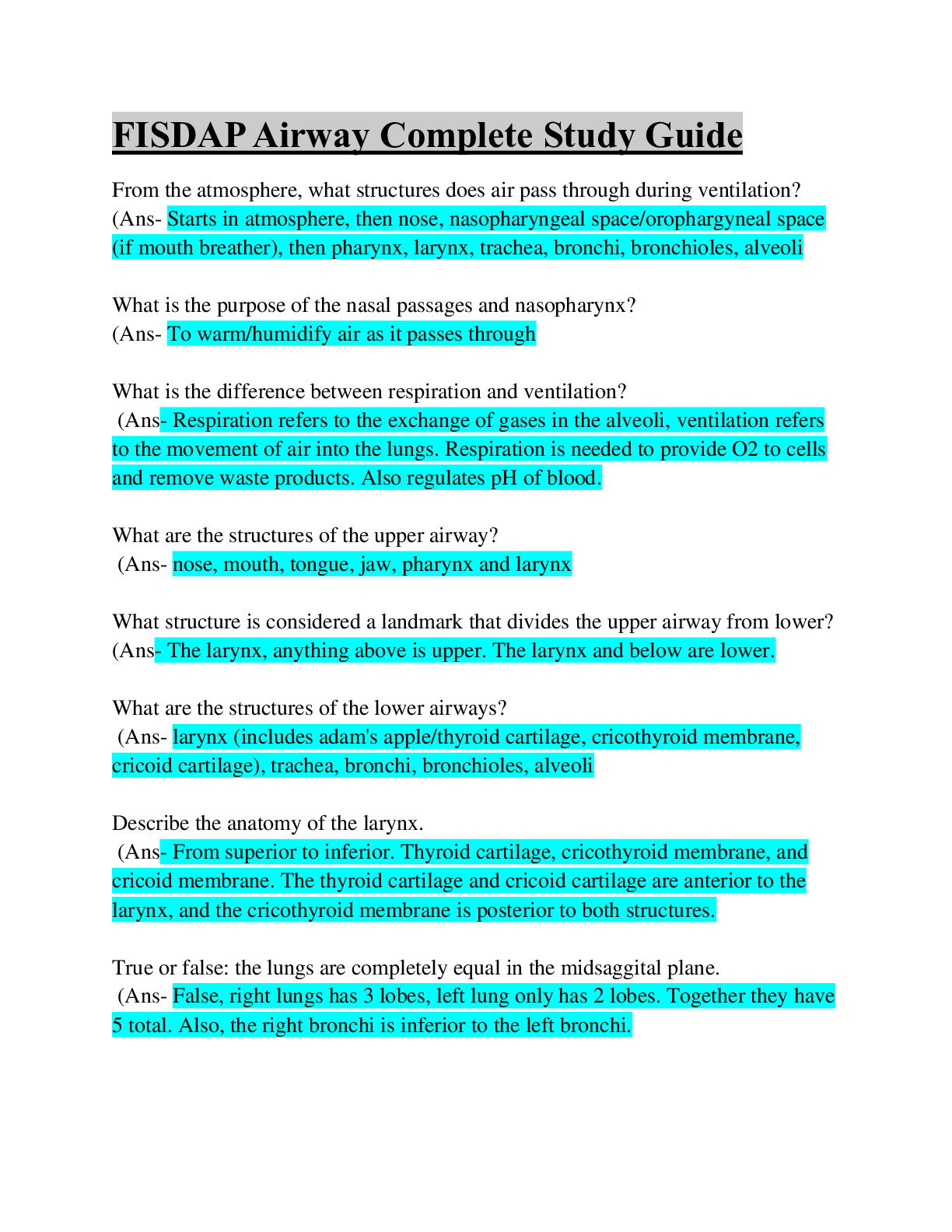


.png)


.png)










.png)
.png)
.png)
.png)
.png)

